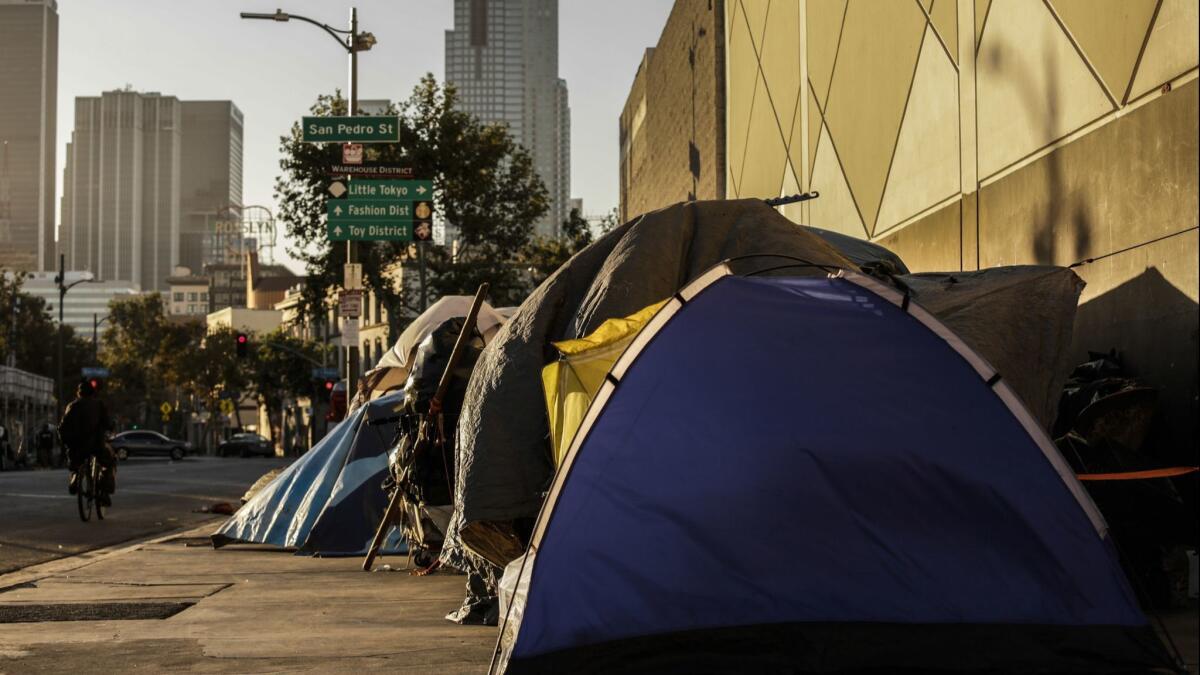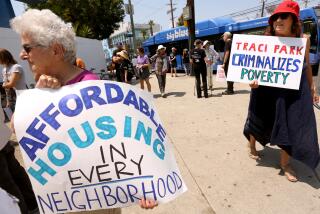Op-Ed: We don’t need protection from the homeless. They need protection from us

- Share via
Two men who slept on downtown Los Angeles sidewalks were beaten to death with a bat last month. In Santa Monica, four other men were attacked while sleeping outside, allegedly by the same assailant, two fatally. In Mission Hills, in the north San Fernando Valley, two unhoused people were burned in an acid attack in the wee hours of Sept. 30 — and the couple said they had been previously doused with gasoline and bleach.
As shocking as this particular spate of attacks is, violence against the homeless is neither uncommon nor unique to Los Angeles.
Early in September, three homeless campers were shot to death in Denver.
In August near Austin, Texas, the charred remains of a 66-year-old homeless man who’d been killed were discovered during a brush fire.
In June, a 70-year-old woman in Scottsdale, Ariz., was sexually assaulted and bludgeoned. A 22-year-old man was later charged with her murder.
Violence against the homeless is neither uncommon nor unique to Los Angeles.
The list goes on. It should be clear that those who have nowhere to sleep but under overpasses, in parks or on sidewalks are the most vulnerable people in a city. Yet when shelters, services or housing for the homeless is proposed in a neighborhood, opponents say it is those blessed to live in a house with doors that lock who are somehow now at risk.
Such cries of concern surface at nearly every community meeting, in petitions and in online comments.
A recent petition opposing a shelter in Sherman Oaks, for instance, states that the shelter will “increase crime” and “jeopardize our safety.” Merchants who opposed the new temporary shelter at El Pueblo in downtown — around which the Los Angeles Homeless Services Authority has begun a cleanup and increased policing — cited safety issues as their top concern. In Venice, residents opposed increased services for the homeless, saying it would cause “severe harm to the surrounding community,” with one woman stating “it would put my children in jeopardy.”
Studies of actual crime rates among the homeless do not bear out these fears, however.
The Guardian, for instance, analyzed 11 city-sanctioned homeless villages of tiny homes in Seattle and Portland, Ore., and found that crime rates went down in five of those neighborhoods, stayed about the same in four and went up only in two. A 2013 randomized controlled trial in a housing-first program in Vancouver, Canada, showed that providing market-rate apartments around the city to homeless mentally ill people reduced crime. A Washington Post analysis of research concluded, “On average, researchers have found supportive housing facilities servicing the homeless and other vulnerable populations rarely lead to higher crime rates.”
Enter the Fray: First takes on the news of the minute from L.A. Times Opinion »
Evidence does show, however, that homeless people are disproportionately the victims of violent crime. In one study that covered five U.S. cities, 49% of the homeless adults surveyed said they had been the victim of a violent attack and 62% had witnessed such an attack. A Los Angeles police report released in May stated between 2016 and 2017, there had been a 14% increase in the number of homeless people who were victims of Part I crimes — such as homicide, rape, robbery and aggravated assault.
Homeless women, whose numbers have risen dramatically in the last few years, are particularly endangered. In a survey conducted by the Downtown Women’s Center in Los Angeles, 50% of the women who sleep in shelters or on the streets of skid row reported they had experienced physical or sexual abuse in the last 12 months.
The great irony of course is that housing for the homeless isn’t the cause of crime; it’s the solution to it. Study after study shows that even those homeless individuals with severe mental illness or suffering from addiction have lower rates of criminal behavior once they have a roof over their head. Building shelters and housing will deter crime and protect lives.
Until those beds exist — and so far, they do not — those on the street need to be protected from violence, just as any city resident deserves to be.
It is clear who is truly unsafe because of homelessness and who just feels uncomfortable because of it. Instead of focusing on making communities safer from the homeless, we must keep the homeless safer in the community.
Sara Shortt is the former director of C3, a homeless outreach program in L.A.’s skid row.
Follow the Opinion section on Twitter @latimesopinionand Facebook
More to Read
A cure for the common opinion
Get thought-provoking perspectives with our weekly newsletter.
You may occasionally receive promotional content from the Los Angeles Times.






